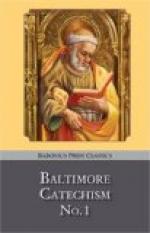333 Q. What do we mean by praying to the saints? A. By praying to the saints we mean the asking of their help and prayers.
334 Q. How do we know that the saints hear us? A. We know that the saints hear us, because they are with God, who makes our prayers known to them.
335 Q. Why do we believe that the saints will help us? A. We believe that the saints will help us because both they and we are members of the same Church, and they love us as their brethren.
336 Q. How are the saints and we members of the same Church? A. The saints and we are members of the same Church, because the Church in Heaven and the Church on earth are one and the same Church, and all its members are in communion with one another.
337 Q. What is the communion of the members of the Church called? A. The communion of the members of the Church is called the communion of saints.
338 Q. What does the communion of saints mean? A. The communion of saints means the union which exists between the members of the Church on earth with one another and with the blessed in Heaven and with the suffering souls in Purgatory.
339 Q. What benefits are derived from the communion of saints? A. The following benefits are derived from the communion of saints: the faithful on earth assist one another by their prayers and good works, and they are aided by the intercession of the saints in Heaven, while both the saints in Heaven and the faithful on earth help the souls in Purgatory.
340 Q. Does the First Commandment forbid us to honor relics? A. The First Commandment does not forbid us to honor relics, because relics are the bodies of the saints or objects directly connected with them or with Our Lord.
“Relic” means a thing left. Relics are pieces of the body—bones, etc. Pieces of saints’ clothing, writing, etc., are also called relics. Pieces of the True Cross, the nails that pierced Christ’s hands, etc., are relics of Our Lord’s Passion. We have no relic of Our Lord’s Body because He took it into Heaven with Him when He ascended. All relics of the saints must be examined at Rome, by those whom the Holy Father has appointed for that work. They must be marked and accompanied by the testimony of the Cardinals, or others who examined them, to show that they are true relics. It would be superstitious to use anything as a relic unless we were sure of its being genuine.
341 Q. Does the First Commandment forbid the making of images? A. The First Commandment does forbid the making of images if they are made to be adored as gods, but it does not forbid the making of them to put us in mind of Jesus Christ, His Blessed Mother, and the saints.




